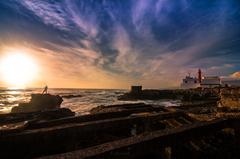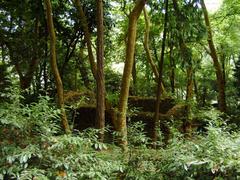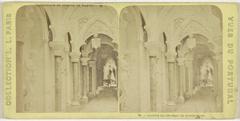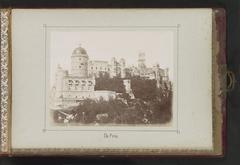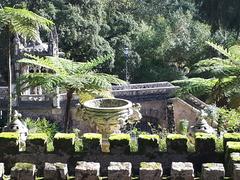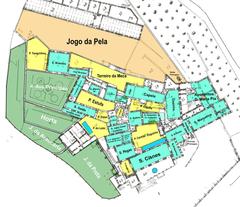MU.SA – Museu das Artes de Sintra: Complete Visiting Guide
Date: 14/06/2025
Introduction
Located in the picturesque town of Sintra, Portugal—a UNESCO World Heritage Site renowned for its romantic architecture and verdant landscapes—MU.SA – Museu das Artes de Sintra stands as a vibrant hub for contemporary and figurative art. Housed in the beautifully repurposed early 20th-century Casino da Vila building, MU.SA offers a unique blend of artistic heritage, architectural character, and community engagement. Since its establishment in 1997 and subsequent evolution, the museum has continually expanded its mission to celebrate both established and emerging artists from Portugal and beyond (Wikipedia, UNESCO).
Whether you are an art enthusiast, a family seeking enriching activities, or a traveler eager to discover Portugal’s creative spirit, this guide provides all essential information on MU.SA visiting hours, tickets, collections, accessibility, educational programs, and travel tips, ensuring a rewarding and memorable visit.
Historical Background
Origins and Evolution
MU.SA originated as the Museu de Arte Moderna de Sintra in 1997, showcasing the acclaimed Coleção Berardo collection—one of the most significant holdings of European and American modern and contemporary art. Following the relocation of this collection to Lisbon’s Centro Cultural de Belém in 2007, the museum was rebranded as MU.SA, broadening its focus to encompass a wider spectrum of contemporary and figurative art. Its core holdings now include the Municipal Collection of Contemporary Art and the Galeria Municipal de Arte, with regular exhibitions featuring both emerging and established artists (Wikipedia, CP.pt Sintra Green Card).
Role in Sintra’s Cultural Landscape
As a key cultural institution, MU.SA contributes to Sintra’s legacy as a crossroads of creativity and intellectual exchange. The museum’s dynamic programming reflects the town’s historic status as a haven for artists and thinkers, and it plays a pivotal role in Sintra’s contemporary cultural fabric (UNESCO, Sintra Romântica).
Architectural Significance
Adaptive Reuse and Heritage
The museum’s home—the former Casino da Vila in Estefânia—embodies early 20th-century Portuguese civic architecture. Its transformation into MU.SA exemplifies adaptive reuse, preserving original decorative features while updating facilities for modern museological standards. Spacious galleries, high ceilings, and natural light create an inviting environment for art appreciation (Wikipedia).
Urban Integration
Located just outside Sintra’s bustling historic center, MU.SA provides a tranquil alternative for cultural exploration. Its proximity to other museums, such as Casa Museu Ferreira de Castro and Casa Museu Anjos Teixeira, forms a vibrant cultural corridor (CP.pt Sintra Green Card).
Interior and Exhibition Spaces
MU.SA’s flexible gallery layouts accommodate a variety of artistic media. The Nova Galeria spotlights emerging talent, while other spaces support thematic and collaborative exhibitions. The facility also includes a municipal bookstore and café-restaurant, promoting community gathering and creative exchange (Wikipedia).
Overview of Collections
Painting
The museum’s collection spans late 20th-century to contemporary Portuguese and European painting, featuring both figurative and abstract works. Rotating displays offer fresh experiences for repeat visitors (Visit Portugal).
Sculpture
Sculptures in bronze, stone, wood, and mixed media provide a tactile and spatial dimension to the museum’s offerings.
Drawing
Drawings—ranging from preparatory studies to finished pieces—offer insight into the creative process and are regularly featured in thematic exhibitions.
Photography
Photography at MU.SA explores Sintra’s landscapes, social themes, and the interplay between nature and urban life, reflecting contemporary issues and local identity (Visit Sintra).
Temporary and Rotating Exhibitions
MU.SA maintains a dynamic schedule of temporary exhibitions, supporting both emerging and established artists.
Lab Arte
This dedicated space empowers new talents through exhibitions, workshops, and artist talks, fostering experimentation and community connection (Visit Portugal).
Thematic & Collaborative Shows
Exhibitions often focus on Sintra’s cultural heritage, contemporary issues, or specific art movements, benefiting from partnerships with other institutions.
Interdisciplinary Events
MU.SA hosts music, theater, and multimedia events, reinforcing its role as a multidisciplinary cultural platform (RPAC).
Notable Spaces
- Municipal Gallery: Flexible venue for retrospectives and thematic exhibitions.
- Municipal Library: Exhibits artist books and archival materials, supporting educational objectives.
Visiting MU.SA: Hours, Tickets, and Accessibility
Visiting Hours
- Tuesday to Friday: 10:00 AM – 6:00 PM
- Saturday & Sunday: 12:00 PM – 6:00 PM
- Closed Mondays and Public Holidays
Check the official website for up-to-date schedules, as hours may change during special events.
Tickets and Admission
- Admission: Free for all visitors.
- Special Exhibitions: Some events may require tickets—verify in advance.
Accessibility
MU.SA is fully accessible, with ramps, elevators, and adapted restrooms. Multilingual materials are provided to serve Sintra’s international audience (Visit Sintra).
Getting There
- Address: Avenida Heliodoro Salgado, 2710-575 Sintra.
- By Train: From Lisbon’s Rossio Station to Sintra; a 10–20 minute walk from the station.
- By Bus: Local buses connect Sintra’s historic center and Estefânia.
- By Car: Limited parking nearby; public transport is recommended during peak seasons.
Educational and Community Initiatives
Open-Door Events
MU.SA regularly hosts open-door events such as International Museum Day, offering guided tours and hands-on workshops for all ages. These days celebrate inclusivity, creativity, and sustainability (juventude.sintra.pt).
Family Workshops
Interactive sessions for families focus on contemporary techniques, creative reuse, and sustainability, fostering intergenerational learning (juventude.sintra.pt).
Educational Exhibitions
Noteworthy exhibitions, such as the 2025 “A Coleção Camoniana de Carvalho Monteiro no 5º Centenário de Camões,” integrate rare archival materials, artworks, and historical narratives (odigital.sapo.pt).
Partnerships
MU.SA collaborates with major institutions—including Museu de Lisboa, Biblioteca Nacional de Portugal, and international partners—enhancing its educational and cultural reach (odigital.sapo.pt).
Guided Tours and School Visits
Tailored guided tours for schools and groups align with curriculum objectives, led by experienced art mediators (visitsintra.travel).
Inclusion Initiatives
The museum ensures free admission for visitors under 17 and over 66, promotes barrier-free access, and regularly hosts inclusive events (sintraportugaltourism.com).
Artist Support
MU.SA’s Municipal Gallery regularly showcases local and emerging artists, accompanied by talks and workshops (sintraromantica.net).
Digital Outreach
The museum’s website and social media channels offer virtual tours, downloadable resources, and updated event information (cm-sintra.pt).
Volunteer Programs
MU.SA encourages local involvement through volunteer opportunities in visitor services, education, and exhibition preparation.
Sustainability Education
Workshops and exhibitions highlight environmental stewardship, creative reuse, and responsible citizenship (juventude.sintra.pt).
Visitor Experience and Engagement
Visitors to MU.SA benefit from interactive exhibits, guided tours, and hands-on workshops suitable for all ages and experience levels. The museum’s tranquil setting, engaging programming, and proximity to Sintra’s notable landmarks create a holistic cultural experience (RPAC).
Nearby Attractions
Combine your MU.SA visit with Sintra’s iconic sites:
- Palácio Nacional de Sintra: Medieval palace with unique chimneys.
- Palácio Nacional da Pena: Colorful hilltop Romanticist palace.
- Quinta da Regaleira: Mystical gardens and the famous Initiation Well.
MU.SA’s location in Estefânia offers peaceful streets and gardens, perfect for photography and relaxation.
Frequently Asked Questions (FAQ)
Q: What are MU.SA’s opening hours?
A: Tuesday to Friday, 10:00 AM – 6:00 PM; Saturday and Sunday, 12:00 PM – 6:00 PM; closed Mondays and holidays.
Q: How much is admission?
A: General admission is free; some special exhibitions may require tickets.
Q: Is the museum accessible for wheelchair users?
A: Yes, MU.SA has ramps, elevators, and accessible restrooms.
Q: Are guided tours available?
A: Yes, in Portuguese and English—book in advance.
Q: Can I take photos?
A: Non-flash photography is generally permitted except where noted.
Q: Can I visit other Sintra sites nearby?
A: Yes, MU.SA is conveniently located near Sintra National Palace, Quinta da Regaleira, and more.
Plan Your Visit
- Check the latest hours and events: MU.SA on Visit Sintra
- Explore on Google Maps: MU.SA Location
- Download the Audiala app for audio guides and exclusive content.
- Follow MU.SA on social media for updates on exhibitions and events.
Summary & Recommendations
MU.SA – Museu das Artes de Sintra merges contemporary artistic expression with Sintra’s rich historic and cultural setting. Through curated collections, accessible facilities, and inclusive educational initiatives, it welcomes a diverse audience and enriches Sintra’s vibrant cultural landscape. Plan your visit, explore nearby treasures, and immerse yourself in the dynamic world of Portuguese contemporary art (Wikipedia, UNESCO, Visit Portugal, Sintra Green Card).
Sources and Further Reading
- Wikipedia – Museu das Artes de Sintra
- UNESCO World Heritage – Sintra Cultural Landscape
- Sintra Green Card Guide, CP Portugal
- MU.SA – Museu das Artes de Sintra, Visit Portugal
- Sintra Municipal Agenda – Educational Initiatives
- Odigital Sapo – Cultural Programs and Educational Partnerships
- Visit Sintra Travel Guide – MU.SA Facilities and Accessibility
- RPAC Portugal – MU.SA Community and Cultural Engagement
- Guia da Cidade – Mu.Sa Museum Sintra Visitor Guide
- Sintra Romântica – MU.SA Museum
- Sintra Portugal Tourism Guide – MU.SA
- Sintra Municipality – MU.SA Official Page

